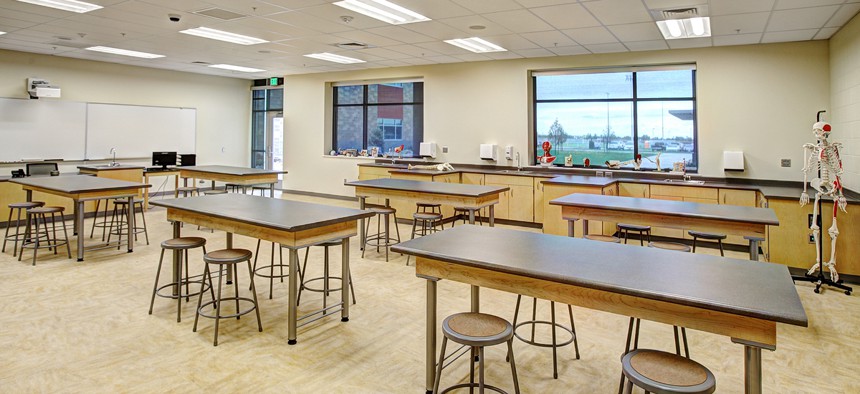Poorer High Schools Offer Less College Prep, Report Finds

High-poverty schools are less likely to offer science courses recommended by college admissions departments, including biology, chemistry and physics. shutterstock

Connecting state and local government leaders
Analysis from the federal government found that high-poverty schools were less likely to offer classes that adequately prepare students for college.
Students attending high schools with relatively high levels of poverty have less access to classes that adequately prepare them for college and often are required to attend four-year universities, according to new research from the nonpartisan federal Government Accountability Office.
“Students from low-income families earn bachelor’s degrees at rates that are significantly lower than their more affluent peers,” says the report, released this month. “This is concerning because higher levels of education are associated with higher lifetime earnings, and a bachelor’s degree, in particular, can be a powerful tool for lifting individuals out of poverty.”
Researchers noted that not all students are interested in pursuing a four-year college degree. “However, the low rates of degree attainment for low-income students raises questions about whether the students who wish to pursue higher education have access to courses that support their admission to college,” they wrote.
To test that access, GAO officials reviewed college preparatory course catalogs in U.S. high schools by analyzing data from the federal Department of Education detailing class offerings by school poverty level, type and size. They also looked at course requirements for admission to public four-year colleges and visited 12 high-poverty high schools in three states.
To start, officials acknowledged that students from low-income families face additional hurdles in preparing for and applying to college. “Poverty can have a profound effect on academic outcomes and college readiness, and students from low-income families are less likely to go to college,” the report says.
Those students may enter high school already lagging behind their peers, and then face additional challenges in preparing for college. Staff members at several high-poverty high schools told GAO officials that “many students are academically behind when they enter high school and are unable to progress to more advanced courses.” And even students who are prepared for such classes may not be able to take them, as high-poverty schools often lack the resources or teaching staff to offer them.
Finally, students struggling with poverty frequently grapple with outside life stressors that can affect their educational experience. “Officials at nine of the 12 schools GAO visited cited the effects of poverty on their students, such as homelessness, hunger, and trauma, that make preparing for college difficult,” the report notes.
Educational opportunities also suffer at schools with higher concentrations of poor students. Researchers found that access to more advanced math and science courses—things like calculus and physics, which are often deemed essential for college admission—decreased as the level of school poverty increased. (Larger high schools were more likely to offer those courses regardless of poverty levels, while charter schools were less apt to have them.)
That directly impacts students’ chances at advancing to a four-year school, as GAO analysis found that “an estimated 95 percent of colleges expected applicants to have completed three or four credits of math...Further, a majority of public four-year colleges specifically recommended that applicants take algebra I, geometry, and algebra II.” Likewise, around 76 percent of colleges expected students to have three or four credits of science, with many specifically recommending biology, chemistry or physics.
Students were more likely to have access to those courses in low-poverty schools. For example, 7 percent of low-poverty schools did not offer the recommended math courses, compared to 17 percent of high-poverty schools. “Further, while 12 percent of low-poverty schools did not offer the recommended science courses (at least biology, chemistry, and physics), 41 percent of high-poverty schools did not,” the report says.
Schools with higher levels of poverty are tackling those roadblocks in different ways, including providing outside support for college advising, aligning graduation requirements with college admission requirements, offering free college admission tests and giving students free access to college courses.
In Georgia, for example, a dual-enrollment program “allows high-school students to earn college credit for free while working on their high-school diploma.” The program covers tuition, fees and books, and has allowed students to earn an associate’s degree when they graduate from high school, “helping to ease the cost burden of college.”
Kate Elizabeth Queram is a Staff Correspondent for Government Executive’s Route Fifty and is based in Washington, D.C.

NEXT STORY: Injunction Sought to Stop Missouri’s New ‘Meat’ Labeling Law




